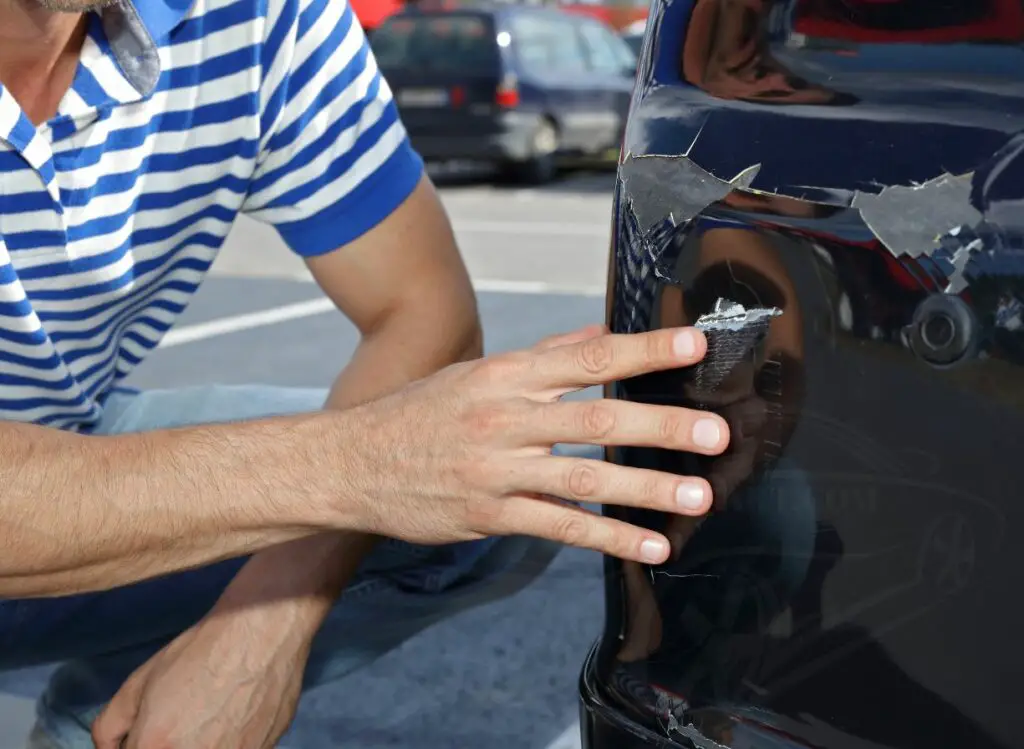
Scratches on cars are quite common and practically hard to completely avoid. Your car certainly has a few scratches, but they aren’t all the same because there are various different sorts of scratches. So, what are the different types of car scratches?
These various sorts of scratches have distinct effects on the paint and necessitate different techniques of repair. While some scratches can be repaired in minutes with a single substance, others may take much longer and require more complicated techniques.
Table of Contents
3 Different types of car scratches
1. Scratches on the Clear Coat
As this form of automobile scratch does not penetrate the color (or base coat) layer, no actual color is removed. Instead, it reflects light unevenly off the surface, becoming visible as a result.
These might be minor or deep scratches due to the depth of the clear coat. Both require different supplies and procedures to repair, but they are both doable at home.
Because the clear coat is the outer covering of your automobile’s paint, these are the most prevalent sort of car scratches.
They can be caused by a variety of factors, including incorrect washing, contact with the vehicle, or gripping a door handle while holding your keys. Scratching the clear coat is quite easy so you should avoid contacting it unless you’re cleaning the automobile.
2. Scratches in the primer
The layer just underneath the clear coat suffers from primer scratches. This is another protective layer that maintains the paint finish on your car appearing sharp and clean. Unfortunately, this kind of damage can change the appearance and color of the car, damaging the smooth surface’s ideal aesthetic.
If automobile scratches penetrate through the clear coat layer and reveal the primer coating, the body paint will deteriorate and there is a danger of rusting if safety precautions are not implemented in a timely manner. This will take more time and skill to correct, and it is recommended that the entire part be painted to avoid uneven paint differences.
3. Scratch paint
The most severe marks an automobile can have are paint scratches. When the paint is scratched deep enough, such as by rocks, keys, or auto crashes, the metal of the car’s body can be seen. Without paint scratch repair, this is the most difficult to restore and can lead to damage to the car’s body.
Scratches like these reveal the car’s exposed metal, which rusts quickly. Rust can form if a paint scrape is left untreated for even a few days.
This might cause irreversible harm to your vehicle and cause major problems to drive over time. It will also have an impact on the car’s market value, as rust is quite unwanted.

NOTE: Severity
Car paint scratches are a form of surface scratch that are usually categorized into four severity levels: 1A, 1B, 2, 3, and 4. That the very first level, 1A, is the least serious scratch that your car can get. The most severe is Level 4.
What Causes Car Scratches?
Car scratches are fairly frequent, and a variety of factors can cause them. A handful of the most common causes of car scratches are listed here.
Improper car wash
Scratches on your car are most likely caused by improper car washing. Your car’s paint is far more sensitive than you might believe, and it is quickly scuffed.
When washing your car, dirt can become caught on your sponge and harm the paint if you don’t utilize suitable techniques. Furthermore, utilizing the wrong materials as a wash rag, such as an old t-shirt, ruins your paint by filling it with scratches.
Not only is your automobile vulnerable to scratches when you wash it by hand, but automatic car washing can also harm your car’s paint.
Road Debris and Rocks
These are major causes of scratches and chipping. Rock chips emerge when pebbles and stones are thrown into the air by another vehicle, then collide with your vehicle and cause damage. Unfortunately, there isn’t much you can do to stop this from happening.
Flying boulders aren’t the only thing that can scratch your automobile while driving; road debris can also scratch it.
When road debris worn tire tread, or other similar materials come into touch with your car, they can produce scratches.
These may usually be avoided by paying strict attention to the road while driving, but they are occasionally unavoidable. These may usually be avoided by paying strict attention to the road while driving, but they are occasionally unavoidable.
These may usually be avoided by paying strict attention to the road while driving, but they are occasionally unavoidable.
Car accidents
This is the most known cause of automobile scratches, as you can’t avoid being in a car accident that results in numerous scratches. They occur when the car’s surface collides with a solid item, such as another vehicle.
These scratches are usually concentrated in the impact location and go deep into the paint.
How to Fix Different Levels of Car Scratches

Various scratch remover treatments depend on the severity level. For example, if there are some minor scratches, you can remove them at home using several techniques that I will discuss shortly, but if the damage is too deep, you should consider using a car scratch repair kit or contacting a body shop. The following are some of the most frequent ways of removing an automobile scratch.
Small scratches: Use touch up paint
An automobile paint scratch that is not too deep and serious can be fixed with paint. Painting the scarred area using a brush or a spray bottle will only worsen matters. Fill the scratch with a sharp needle or a toothpick. Before choosing a color, check the paint code on your car’s right door or in the owner’s handbook.
Minor scratches: Car scratch remover
Car scratch removers fill gaps left by minor scratches where the paint coating is damaged, making it appear as if there was no scratch.
You’re wondering if it works on major scratches? No, it isn’t going to happen. You’ll have to look into other possibilities.
Rubbing compound
Your fingernail can be used to judge a simple surface-level scratch. If your nail seems unable to catch it, a special rubbing chemical can be used to remove it.
This is accomplished by thoroughly cleaning the afflicted area with car soapy water and then wiping it clean with a microfiber cloth. A tiny amount of rubbing compound is now applied with a buffing pad.
Applying light pressure, the compound is vigorously circularly rubbed into the scratched region.
The goal is to remove a small amount of scratched clear coat. The entire procedure is repeated over and over again. Lastly, the area is cleaned and dried in the open air.
Mild scratches: Car scratch repair kit
Mild scratches can also be removed with a scratch repair kit purchased from a retailer.
A polishing pad and scratch removal solution are included with the set. The surface is initially washed to remove any dust or debris that may have accumulated on it.
A microfiber cloth is then used to dry the surface. A tiny amount of solution is rubbed over the surface using the buffing pad. The excess is washed away, and the area is allowed to heal.
There have been mixed reviews on utilizing a scratch removal kit, with some customers claiming no results or good results just for minor scratches.
Deep scratches: Professional denting and painting
There is no substitute for skilled dent painting. Having your car scratch removed by a denting painting expert can ensure that you get a showroom-like finish. Here’s a taste of what’s to come.
The professional begins by carefully cleaning the vehicle to remove all impurities and trash. The specialist removes additional paint from the area with sandpaper until the center of the damage can be seen.
To avoid future scratches in the opposite direction, the paint removal movement should be on the side of the scratch. Furthermore, several grits of sandpaper are utilized for various levels of scratches, such as 1500, 2000, and so on.
Check out this video for more ideas on how to remove car scratches!
Can I Buff Car Scratches?
Buffing car scratches seems to be a common practice when it comes to fixing scratches on car paint. And yes, you can buff car scratches to some extent. Here are the general steps you can follow:
Clean the area
Start by thoroughly washing the scratched area with soap and water. This will remove any dirt, debris, and loose particles that could interfere with the buffing process.
Assess the damage
Determine the depth and severity of the scratches. If the scratches are deep, extend beyond the clear coat, or have exposed bare metal, it may require professional repair.
Select the right materials
Choose a high-quality automotive rubbing compound or a scratch remover that matches the paint color of your car. Additionally, you’ll need a soft microfiber cloth or a buffing pad, and some clean water.
Apply the rubbing compound
Put a small amount of the rubbing compound on the cloth or pad and apply it to the scratched area. Work in a circular motion, applying gentle pressure. Be careful not to apply too much force, as it can further damage the paint.
Buff the scratches
Continue buffing the scratches until you see improvement. Check your progress regularly and reapply the rubbing compound as needed. Be patient, as it may take several applications to achieve the desired results.
Clean and assess
Once you’re satisfied with the buffing, clean the area with a damp cloth to remove any residue. Inspect the scratches under different lighting conditions to ensure they have been adequately reduced or removed.
It’s important to note that while buffing can improve the appearance of minor scratches, deep or extensive damage may require professional attention. If you’re uncertain or uncomfortable performing the task yourself, it’s best to consult a professional auto body shop or a qualified detailer for assistance.
How to Avoid Car Scratches

Even though scratches are prevalent, there are things you can take to assist in minimizing and preventing them.
Applying a wax layer to the paint can help protect it from light-clear coat scratches.
A wax coating will give a thin protective layer to your car’s clear finish, further protecting it. Although it will not protect against severe scratches, it may aid in the prevention of some minor blemishes.
Another strategy to avoid scratches is to learn how to wash your car properly. One of the most common ways an automobile becomes scratched is through hand-washing inappropriately.
Hand-washing isn’t the only way to harm your car when it’s washed. Automatic car washes, particularly touch car washes, can potentially do a lot of damage to your paint.
You should also be mindful of typical scratching points, like door handles. Identify the areas of your car that have been scratched and try to decide what is creating the scratches.
Common Myths About Car Scratch Repair
There are several myths and misconceptions surrounding car scratch repair. Let’s debunk some of the most common ones:
- Myth 1: Toothpaste can fix any scratch: While toothpaste can temporarily reduce the appearance of minor surface scratches, it is not a permanent solution and may not work effectively for deeper or more severe scratches.
- Myth 2: DIY methods are as good as professional repairs: DIY methods can be useful for minor scratches, but for more significant damage, professional repair services have the necessary expertise, tools, and materials to achieve a high-quality and long-lasting repair.
- Myth 3: All scratches require a paint job: Not all scratches require a full paint job. Many can be effectively repaired through spot treatments or touch-up paint techniques.
- Myth 4: Scratches can be completely invisible after repair: While professional repairs can significantly minimize the visibility of scratches, it is unrealistic to expect them to completely disappear, especially for deep or extensive damage.
- Myth 5: Scratch repair is costly: Scratch repair costs vary depending on the damage’s extent and severity. Addressing scratches early can often be more affordable than letting them worsen and require extensive repairs.
Frequently Asked Questions
Can car scratches be completely removed?
While professional repairs can significantly reduce the visibility of scratches, they are unlikely to be completely removed, especially for deep or extensive damage.
Are DIY scratch repair kits effective?
DIY scratch repair kits can be useful for minor scratches, but it is advisable to seek professional assistance for more significant or deep damage.
Can car scratches lead to rust formation?
If scratches are left untreated, they can expose the metal beneath the paint, making it susceptible to rust formation. It is essential to address scratches promptly to prevent rusting.
How can I prevent car scratches?
You can minimize the risk of car scratches by parking carefully, using protective covers, practicing gentle cleaning techniques, and avoiding contact with sharp objects.
How much does professional scratch repair cost?
The cost of professional scratch repair depends on the extent and severity of the damage. It is best to consult with a reputable repair service for an accurate assessment and cost estimation.
Conclusion
Car scratches are an unfortunate but common occurrence that can impact the appearance and value of your vehicle. Understanding the different types of car scratches, their causes, prevention methods, and available repair options is crucial for maintaining your car’s aesthetic appeal and resale value.
Whether through DIY methods for minor scratches or professional repair services for more significant damage, addressing scratches promptly ensures your car remains in top condition.
Further Reading:
Hi everyone, My name is Ollie Barker.
As a seasoned auto expert I have 25 years of experience working in repair and detailing shops. I love to share my tips & tricks to all car lovers, so that’s why I’m here at Automotive Gearz publishing my content, sharing my passion. Also, I’ve been giving my recommendations on which products are the best to have on the market. I always thought it was hard to pick the right part, so hopefully I can make that a bit easier for you.
Hope you enjoy your time on my little blog!







